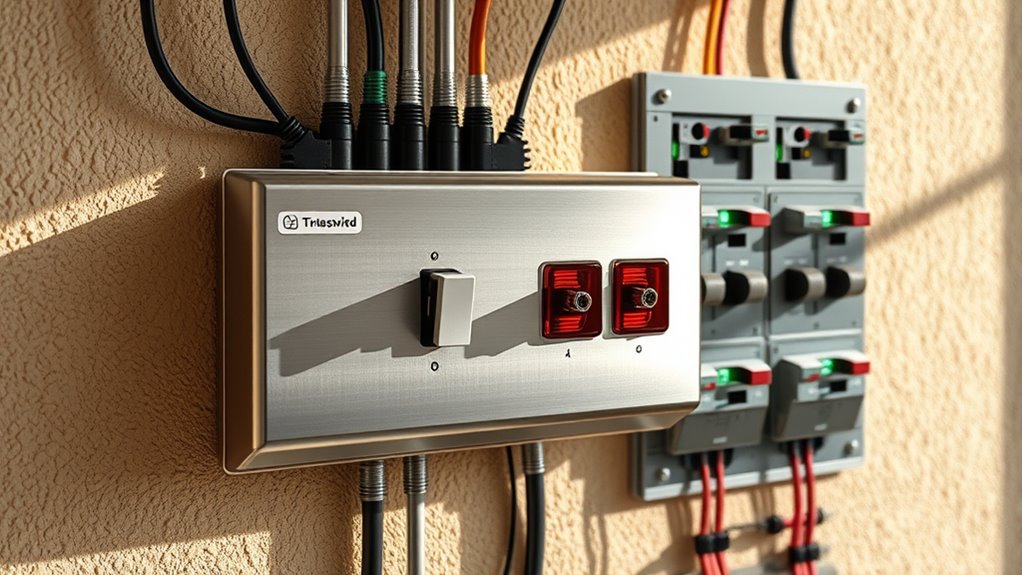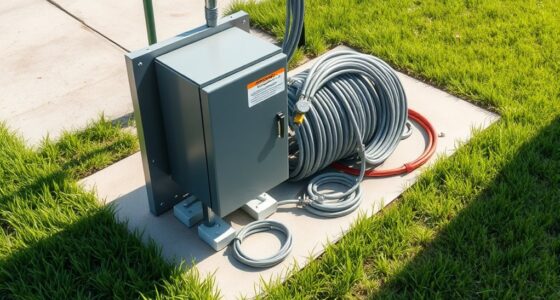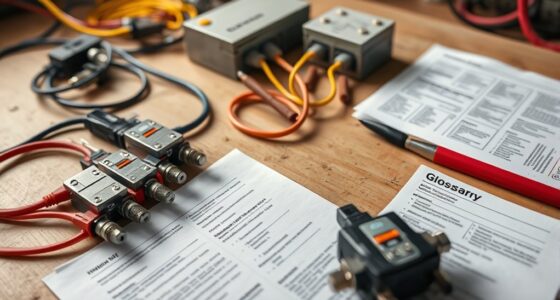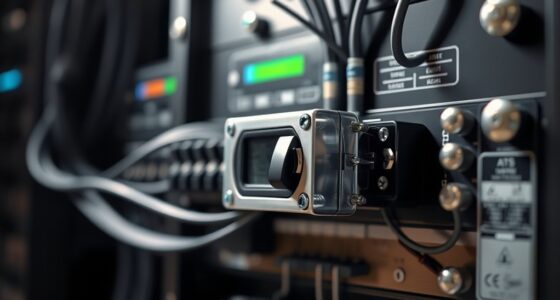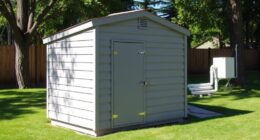A manual transfer switch lets you safely switch power from the utility to your generator during outages. If it’s not engaging properly, shows signs of faults, or has inconsistent power transfer, troubleshooting steps include checking connections, ensuring your generator runs correctly, and confirming the switch is in the right position. Always follow safety procedures and consider professional help for complex issues. Keep exploring to learn more about maintaining and troubleshooting your switch effectively.
Key Takeaways
- Verify proper connections and ensure the switch is in the correct position for power transfer.
- Check for signs of malfunction such as engagement failure, tripping, or inconsistent power flow.
- Inspect wiring for damage, corrosion, or loose connections and confirm generator functionality.
- Follow safety procedures: disconnect power sources, ground equipment, and avoid working on live circuits.
- Contact a licensed technician for complex issues, persistent faults, or electrical damage diagnosis.
Understanding the Functionality of a Manual Transfer Switch
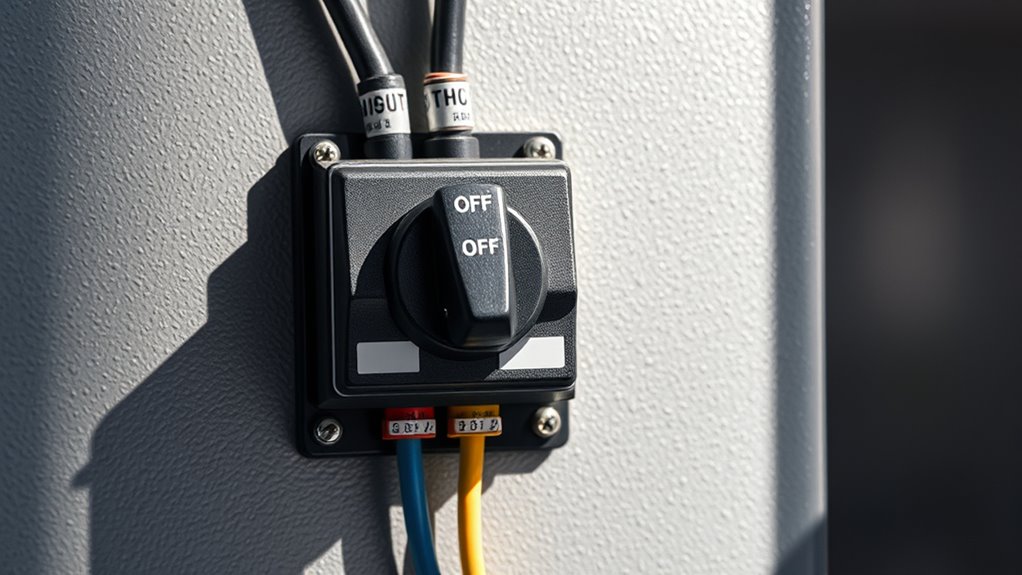
A manual transfer switch is a device that allows you to safely switch your power source from the utility grid to a backup generator during an outage. Unlike automatic operation switches, manual switches require you to intentionally change the power source, giving you control over when the generator powers your home. While manual switches don’t automatically manage load distribution, they do help with load management by isolating circuits and preventing overloads. This guarantees your generator isn’t overwhelmed and your appliances remain protected. The switch connects your home’s electrical system to the generator, enabling safe power transfer. Understanding how a manual transfer switch functions helps you operate it correctly, ensuring a smooth transition during outages and safeguarding your electrical system.
Common Indicators of Transfer Switch Malfunction
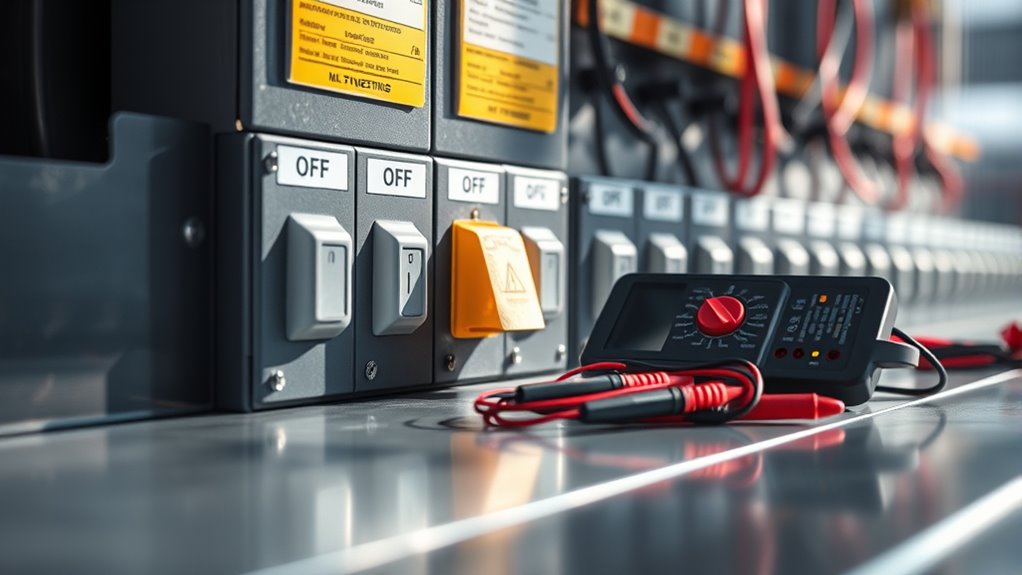
You should stay alert for signs that your transfer switch isn’t working properly. Unusual clicking sounds, power fluctuations, or alert lights can all indicate a problem. Recognizing these signs early helps you address issues before they cause more serious damage. Additionally, environmental considerations such as fire safety regulations and proper campsite selection highlight the importance of proactive maintenance to prevent electrical hazards.
Unusual Clicking Sounds
Unusual clicking sounds from your transfer switch often signal a malfunction that requires attention. These noises are typically relay noise, caused by the relay repeatedly engaging and disengaging, indicating a problem with the switch’s components. You might also notice the clicking coming from the circuit board, suggesting an electrical fault or a stuck relay. If the switch clicks excessively or unpredictably, it can lead to improper transfer of power between sources. This behavior may be due to worn-out relays, loose connections, or damaged circuitry. Ignoring these sounds can cause further damage or failure of the transfer switch. To troubleshoot, inspect the relay connections, listen carefully for the pattern of the clicks, and consider replacing faulty relays or consulting a professional if the circuit board shows signs of damage. Regular maintenance and understanding the transfer switch components can help prevent such issues.
Power Loss or Fluctuations
Power loss or fluctuations are common signs that your transfer switch may not be functioning properly. These issues often indicate problems with generator maintenance or electrical connections. Start by checking your circuit breakers to ensure none are tripped or faulty, as this can cause inconsistent power flow. If your transfer switch isn’t reliably switching between utility power and generator, it might be due to worn components or poor contact points. Regular generator maintenance, such as inspecting fuel levels, cleaning filters, and testing the system, can prevent power fluctuations. Additionally, verify all wiring connections are secure and free from corrosion. Proper installation practices can help prevent operational problems and ensure reliable performance. Addressing these basic checks helps maintain reliable operation and avoids more serious malfunctions that could compromise your power supply.
Indicator Light Alerts
Indicator lights on your transfer switch serve as essential signals of its operational status, alerting you to potential malfunctions. When an indicator light is flashing or stays on continuously, it often signals a problem needing troubleshooting tips. Here are common indicators:
- Steady Power Light: Confirms proper operation; if off, check power supply connections.
- Flashing Error Light: Indicates a fault, such as wiring issues or switch malfunction.
- No Light at All: Implies power failure or a blown fuse; inspect the circuit breaker.
- Additional Signs of Malfunction can relate to system alerts that help diagnose issues early.
Step-by-Step Troubleshooting for Power Transfer Issues
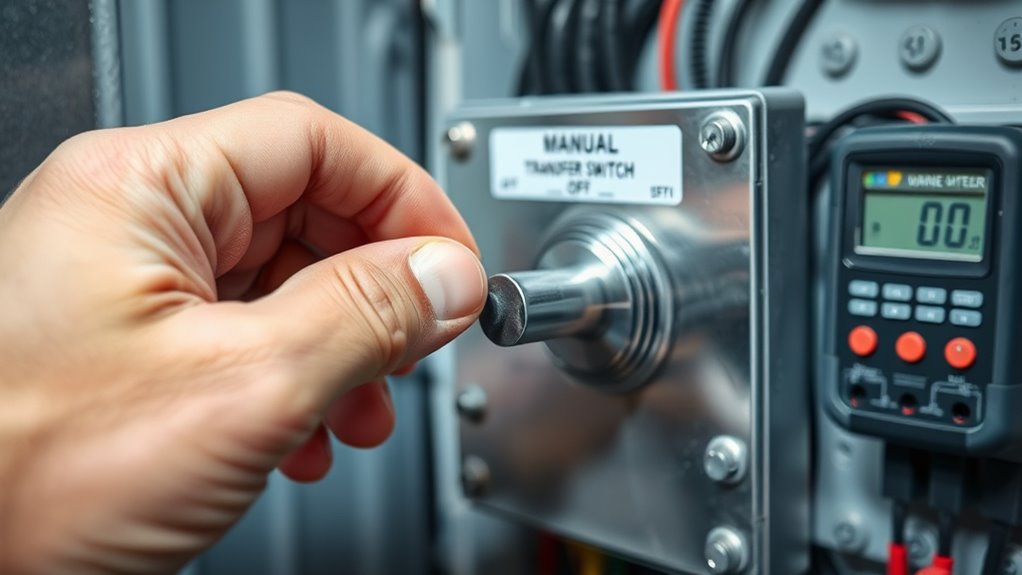
When troubleshooting power transfer issues with your manual transfer switch, start by verifying that the switch is properly connected to both the main power source and the generator. Ensure all wiring follows the installation guidelines provided by the manufacturer, as improper connections can cause transfer failures. Check that the switch is in the correct position for transfer, and confirm the generator is functioning properly. If issues persist, review the switch’s manual for specific troubleshooting steps. Keep in mind that making unauthorized modifications might void your warranty, so consult the warranty considerations before making any adjustments. Confirm all connections are secure, and inspect for visible damage. Proper transfer switch operation is essential for safe and reliable performance. If problems continue after these steps, consider contacting a professional electrician to avoid risking safety or invalidating your warranty.
Safety Precautions Before Performing Maintenance
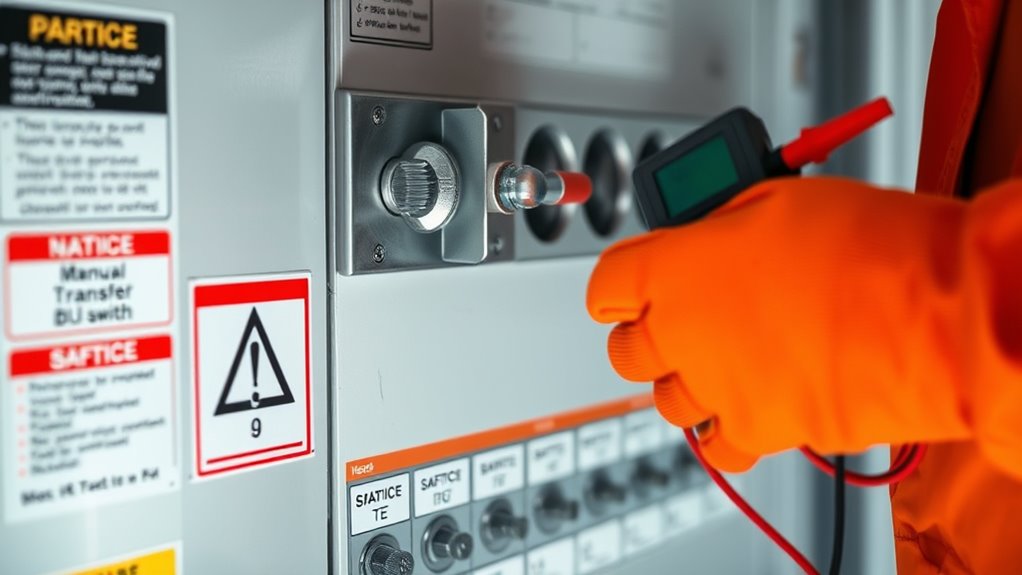
Before starting maintenance on your manual transfer switch, always prioritize safety by disconnecting all power sources. This prevents electrical shocks and equipment damage. Next, perform grounding procedures to make sure the switch is properly grounded, reducing the risk of static buildup or accidental energization. Finally, familiarize yourself with the emergency shutdown procedures, so you can quickly cut power if needed. It is also important to ensure that all privacy and cookie settings are properly managed to protect your information during the process. Make certain you check for: 1. Power sources are fully disconnected and locked out. 2. Grounding connections are intact and secure. 3. Emergency shutdown protocols are clear and accessible. Following these steps minimizes hazards and prepares you for safe maintenance. Always verify that no residual voltage remains before proceeding with any work.
When to Seek Professional Assistance

If you encounter complex wiring issues or your transfer switch keeps malfunctioning despite your efforts, it’s time to call in a professional. Attempting to fix persistent operational problems on your own can be risky and may cause further damage. Trust experts to diagnose and resolve these issues safely and effectively. Recognizing when to seek professional assistance can help prevent safety hazards and ensure your system operates smoothly.
Complex Wiring Issues
Complex wiring issues can quickly become dangerous and difficult to troubleshoot on your own. If you encounter signs of complex wiring problems, like inconsistent power transfer or unusual circuit behavior, it’s best to seek professional help. Attempting to fix complex wiring without proper knowledge can lead to electrical shock or equipment damage. When facing such issues, consider these signs:
- Troubleshooting techniques don’t resolve the problem after multiple attempts.
- You notice exposed or damaged wiring that’s beyond simple repairs.
- The wiring setup appears tangled or improperly configured, risking safety.
- Recognizing the importance of proper vibrational energy can help prevent further complications.
In these cases, a licensed electrician has the expertise to diagnose and fix complex wiring safely. Rushing into repairs can escalate risks, so knowing when to call a professional ensures safety and proper functioning.
Persistent Operational Problems
Persistent operational problems with your manual transfer switch can be frustrating and potentially dangerous if they continue despite your efforts. If issues persist, it’s time to seek professional help, especially if you’re unsure about solar compatibility or load balancing. Troubleshooting beyond basic checks may involve complex wiring or electrical assessments that require expertise.
| Symptom | Recommended Action |
|---|---|
| Switch won’t fully engage | Consult an electrician to verify wiring and load distribution. |
| Frequent tripping or faults | Have a professional evaluate system compatibility, including solar inputs. |
| Inconsistent power transfer | Seek expert help to check load balancing and switch integrity. |
| Unclear troubleshooting steps | Always contact a licensed technician for safe diagnosis and repair. |
Maintaining Your Manual Transfer Switch for Longevity

Regular maintenance is essential to guarantee your manual transfer switch operates reliably when you need it most. To ensure longevity, follow these steps:
- Regularly inspect the switch for signs of wear or corrosion, referencing installation guidelines to guarantee proper setup.
- Keep the switch clean and dry, avoiding moisture that could compromise internal components and void warranty considerations.
- Test the switch periodically to confirm it engages properly and consult the manufacturer’s instructions for troubleshooting tips.
- Be aware that security measures in your home, such as surveillance or alarm systems, can help protect your investment in backup power solutions by deterring theft or vandalism.
Adhering to installation guidelines during initial setup helps prevent future issues, while routine checks safeguard your warranty coverage. Proper maintenance not only extends the switch’s lifespan but also ensures it functions seamlessly during power outages, giving you peace of mind.
Frequently Asked Questions
Can a Manual Transfer Switch Be Used With Generator Types Other Than Portable?
Yes, you can use a manual transfer switch with generators other than portable ones. Just make certain the switch installation is compatible with your generator’s power output and type. Check generator compatibility before installation, so it safely handles your power source. Proper switch installation is essential for safety and functionality. If you’re unsure, consult an electrician to verify that your generator and manual transfer switch work well together.
What Are the Signs of a Failed Transfer Switch Relay?
If your transfer switch relay has failed, you’ll notice signs of switch malfunction such as power not switching correctly or the backup power not activating. You might also hear clicking sounds but see no response, indicating relay failure. These issues mean the relay isn’t properly controlling the circuit. It’s vital to address relay failure promptly to prevent further switch malfunction and guarantee your generator system operates safely and reliably.
How Often Should I Test My Manual Transfer Switch?
You should test your manual transfer switch at least once every three to six months to guarantee it functions properly. While some experts suggest testing more frequently, a regular maintenance schedule helps prevent surprises during power outages. Investigating the theory that more frequent testing extends switch lifespan reveals it’s true—consistent checks catch issues early. By adhering to this testing frequency, you keep your system reliable and assure a smooth transition during emergencies.
Is It Necessary to Turn off the Main Breaker When Switching Loads?
You don’t need to turn off the main breaker when switching loads, but for switch safety and load prioritization, it’s recommended. Turning off the main breaker minimizes risks, prevents electrical arcs, and guarantees a safer transfer process. Always follow manufacturer instructions and local codes. Proper switch safety practices help protect you and your system, making load switching smoother and reducing potential damage or hazards during manual transfer operations.
What Is the Typical Lifespan of a Manual Transfer Switch?
Think of your manual transfer switch like a trusty old car—if you follow proper installation guidelines and safety precautions, it can serve you well for 10 to 20 years. Usually, with regular maintenance, you can extend its lifespan. Keep in mind, neglecting these guidelines may shorten its life or cause safety issues. So, treat it with care, schedule periodic checks, and it’ll keep your power safe and reliable for years to come.
Conclusion
So, after all that troubleshooting, you might think your transfer switch is invincible. But remember, even the best DIY skills can’t replace a professional’s touch when things get truly complicated. Irony alert: your switch’s longevity depends on your attention—and sometimes, that means calling in the experts. Don’t wait until a power outage leaves you in the dark—stay safe, stay prepared, and know when to get help before it’s too late.
